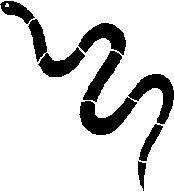|
Unlike mammals, snakes do not have separate urinary,
reproductive and anal openings. Instead the urinary, digestive and
reproductive tracts all empty into a common chamber, the Cloaca. All
of the waste material is stored here until it can be eliminated. The
cloaca opens to the outside through a transverse sit just behind the
snakes tail.
Some snakes also have special glands, which also empty into the
cloaca. These glands contain a foul-smelling musk, which can be
ejected when the snake is frightened or threatened.

The snake's stomach is very strong and elastic, and can expand
enormously to obtain the large prey animals eaten by snakes. The
digestive juices are powerful so nearly all of the prey is digested
which includes most of the bones and teeth. Since snakes digest
their "whole prey", they can go for a long period of time without
having to eat.
Most reptiles (except the crocodilians), snakes have a very
primitive three-chambered heart that is not quite as effective as the
four-chambered hearts found in mammals. In snakes the blood is
pumped into one top chamber (oxygen depleted) then the oxygen rich
blood from the lungs gets pumped into the other top chamber. They
all get empties into the lower one and then circulated throughout
the body. Because of this inefficient method of distributing oxygen,
even the most active snakes tire easily and have to rest for a
period of time.
BACK TO TOP
WEBSITE CREATED BY: Michael Connor
|


